Papers by Sibele de Andrade Melo Knaut
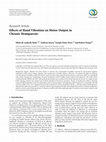
International Journal of Brain Science, 2015
Background.Muscle vibration has been shown to increase the corticospinal excitability assessed by... more Background.Muscle vibration has been shown to increase the corticospinal excitability assessed by transcranial magnetic stimulation (TMS) and to change voluntary force production in healthy subjects.Objectives.To evaluate the effect of vibration on corticospinal excitability using TMS and on maximal motor output using maximal voluntary contraction (MVC) in individuals with chronic hemiparesis.Methodology.Nineteen hemiparetic and 17 healthy control subjects participated in this study. Motor evoked potentials (MEPs) and MVC during lateral pinch grip were recorded at first dorsal interosseous muscle in a single session before, during, and after one-minute trials of 80 Hz vibration of the thenar eminence.Results.In hemiparetic subjects, vibration increased MEP amplitudes to a level comparable to that of control subjects and triggered a MEP response in 4 of 7 patients who did not have a MEP at rest. Also, vibration increased the maximal rate of force production (dF/dtmax) in both contro...
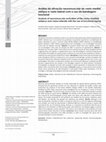
Acta Fisiátrica, 2014
Alterações musculares e anatômicas são em sua maioria responsáveis pela síndrome patelofemoral (S... more Alterações musculares e anatômicas são em sua maioria responsáveis pela síndrome patelofemoral (SDPF). Sabendo que a musculatura do quadríceps é de grande importância na estabilização da patela, quesiona-se como o músculo Vasto Medial Oblíquo (VMO) inluencia na estabilização patelar evitando a SDPF. Muitos pesquisadores tem invesigado o uso da bandagem funcional como meio de aivação muscular. Objeivo: O presente estudo teve como objeivo analisar o uso da bandagem como meio de aivação do VMO no exercício de agachamento. Método: A aividade dos músculos VMO e Vasto lateral (VL) foi avaliada através de eletromiograia durante o agachamento com adução e o agachamento com o uso de bandagem. A amostra composta por 39 indivíduos foi dividida em quatro grupos: indivíduos do sexo masculino sedentários e atletas, e indivíduos do sexo feminino sedentárias e atletas. Resultados: Embora tenha sido encontrada uma maior aivação do VMO em relação ao VL, com a presente metodologia e variáveis estudadas, não foi possível demonstrar diferença estaísica entre os grupos nos agachamentos com e sem o uso da bandagem. No entanto, é importante ressaltar que a ausência de diferença na aivação do VMO durante o agachamento com adução e com bandagem sugerem um efeito posiivo e facilitador da bandagem na aivação muscular. Este resultado é muito importante no tratamento de lesões agudas onde o movimento aivo está limitado. Conclusão: Sugere-se a execução de novos estudos aonde outros parâmetros da eletromiograia e esimulação relexa sejam abordados, a im de invesigar o real papel da bandagem funcional na aivação muscular.
e-News Somatosens Rehab, 2019
When new or emerging practices become available, there is a need to generate knowledge and eviden... more When new or emerging practices become available, there is a need to generate knowledge and evidence to support these novel approaches. Partnerships between clinical or community partners and academic programs have formally developed in occupational therapy (OT) and have been referred to as the Scholarship of Practice Model or Practice-scholar Programs. Although these models may take on many different forms, they all value linking the production of theoretical and empirical knowledge to clinically relevant issues in practice. This requires meaningful partnerships between researchers and clinicians. Our publication on somatosensory rehabilitation is a concrete example of these partnerships, which we will briefly describe in this editorial.
GI Douleur Société Française de Physiothérapie, 2019
http://gi-douleur.fr/prendre-en-charge-les-douleurs-neuropathiques-cest-facile/
Les objectifs de... more http://gi-douleur.fr/prendre-en-charge-les-douleurs-neuropathiques-cest-facile/
Les objectifs de l’équipe interdisciplinaire :
Diminuer la douleur de 50 % (Cruccu & Truini, 2017) ;
Diminuer le score au Questionnaire de la Douleur St-Antoine de 30 pts ou plus ;
Atteindre un score, au questionnaire de la douleur, inférieur à 20 pts (ou un score inférieur à 3 cm sur une l’Echelle Visuelle Analogique).
https://urlz.fr/9MWE
e-News Somatosens Rehab, 2019
In the somatosensory rehabilitation method, a generator of vibrations is used for the diagnostic ... more In the somatosensory rehabilitation method, a generator of vibrations is used for the diagnostic testing of axonal lesions, the treatment of mechanical allodynia by Distant Vibrotactile Counter Stimulation (DVCS) and stimulating substitution in hypoaesthetic territories through neuroplasticity (Spicher, 2006). Unfortunately, this generator of vibrations is not available in the Netherlands. Therefore, the therapy can only be done by performing the home program of relearning the interpretation of tactile stimuli to the skin, using the neuroplasticity of the brain. When I started to use the somatosensory rehabilitation method in neuropathic pain patients in 2012, I was curious my results could be as positive as I had seen in Fribourg during my first course.
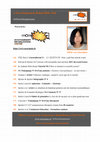
e-News Somatosens Rehab, 2018
The goal of the somatosensory rehabilitation approach is to translate the theory of adaptive neur... more The goal of the somatosensory rehabilitation approach is to translate the theory of adaptive neuroplasticity into practice and to yield solid evidence of treatment efficacy. However, there is always a long way to go from concept to practice. “How to communicate and reach an agreement among team members, including doctors, other therapists, and patients?”, “How to motivate patients to adhere to treatment, as it is relatively a long treatment process?”, “How to convince the insurer to support the patient’s treatment?” They are all predictable obstacles faced to the therapists. Eva admits that this approach cannot be effective if the therapist only works within her own corner. One of the remarks made during the course: be an agent of change echoed in the whole class. With this new approach, what we learn is not only a treatment method; more importantly, it can shape our thoughts about pain.
e-News Somatosens Rehab, 2018
En août 2016 (Finnerup et al., PAIN®), un groupe d’experts internationaux a publié un NOUVEAU con... more En août 2016 (Finnerup et al., PAIN®), un groupe d’experts internationaux a publié un NOUVEAU consensus quant au diagnostic des douleurs neuropathiques. Un algorithme a été proposé, où la neurographie sensitive pure n’est que la dernière de quatre étapes – et NON pas la seule et unique façon de diagnostiquer des douleurs neuropathiques . Ces quatre étapes d’un raison-nement clinique qui mènent au diagnostic de douleurs neuropathiques sont les suivantes :
1. La plainte du patient ;
2. L’anamnèse clinique ;
3. L’examen clinique ;
4. La neurographie sensitive pure.
Ce groupe d’experts a été mandaté par l'International Association for the Study of Pain (IASP), sous l’égide de son ancien président, médecin allemand et professeur de neurophysiologie : Prof. Dr. med. Rolf–Detlef Treede.
e-News Somatosens Rehab, 2018
Who has never suffered from pain? It does not matter if this pain was physical or emotional. Oh G... more Who has never suffered from pain? It does not matter if this pain was physical or emotional. Oh God, and how difficult it is to describe it! Many times the people around us do not seem to understand the extent of our pain. And this is legitimate. Each one interprets his/her pain according to his/her own threshold of pain, but also, in relation to previous experiences of pain. These experiences are either from situations we have lived ourselves or from the observation of the suffering of others.
e-News Somatosens Rehab, 2017
From simple discomfort to intolerable agony
Hypersensitive, irritable, nervous: « that’s not me ... more From simple discomfort to intolerable agony
Hypersensitive, irritable, nervous: « that’s not me »
Contrarily to all common sense
Who is to blame? : The somatosensory nervous system
e-News Somatosens Rehab, 2018
Because big randomized controlled trials cost a lot to run, it was important for us to be sure th... more Because big randomized controlled trials cost a lot to run, it was important for us to be sure there was some evidence to support going ahead with a big study, even if that evidence can only be considered low to moderate strength right now. One of the strengths of this study was that we included all the records, even people who dropped out of treatment. Another strength of this study was everyone had been screened using the Budapest criteria, so we were confident every record we reviewed represented a person with CRPS. This study became part of my PhD thesis at McMaster University on advancing rehabilitation for complex regional pain syndrome.
e-News Somatosens Rehab, 2017
De um simples desconforto às tormentas insuportáveis
A flor da pele, irritável, agressivo: “não ... more De um simples desconforto às tormentas insuportáveis
A flor da pele, irritável, agressivo: “não sou eu”
Ao contrário do bom senso
Quem é o responsável? O sistema nervoso somatosensorial
e-News Somatosens Rehab, 2016
The third study evaluated the use of somatosensory rehabilitation to decrease allodynia in a retr... more The third study evaluated the use of somatosensory rehabilitation to decrease allodynia in a retrospective cohort of patients with CRPS. These patients had CRPS as defined by the Budapest criteria and had static mechanical allodynia as defined by a painful response to stimulation using a monofilament (15g). The treatment in this study included: 1) vibrotactile counter-stimulation applied away from the painful region; 2) vibration; and 3) avoidance of stimuli that induce pain. Following treatment, allodynia was completely resolved in 56% of the initial sample and pain qualities were reduced in 48 patients. The somatosensory rehabilitation program used in this study showed a large effect size in this sample of patients with upper extremity CRPS and provides preliminary evidence to support this method of treatment for patients with CRPS.
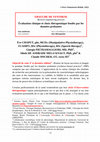
e-News Somatosens Rehab 14(2), 2017
Objectif de cette 4e et dernière édition : illustrer de façon succincte et imagée la pratique fo... more Objectif de cette 4e et dernière édition : illustrer de façon succincte et imagée la pratique fondée par les données probantes (evidence-based practice , EBP) comprise par une clinicienne. L’appréciation de la valeur clinique des résultats de recherche sera présentée via la présentation de caractéristiques métrologiques des tests et des interventions. La validité, la fidélité et la sensibilité ainsi que quelques notions statistiques de base seront expliquées. En dernier lieu, le niveau de preuve des évidences scientifiques sera discuté.
Le besoin d’intégrer l’EBP trouve ses raisons profondes dans le but d’améliorer la pratique clinique et ses résultats chez nos patients. L’EBP est un sujet d’intérêt depuis le milieu du XIXe siècle. Sackett et collaborateurs en donnent une définition plus actuelle en 1996. L’EBP est la prise en charge personnalisée de chaque patient grâce à un processus décisionnel délibéré, consciencieux et judicieux intégrant les meilleures données probantes disponibles, l’expertise clinique individuelle du professionnel et les valeurs, préférences et circonstances du patient (Fig. 1).
e-News Somatosens Rehab, 2017
Imagine that you are a therapist. A young woman has just arrived in the waiting room of your clin... more Imagine that you are a therapist. A young woman has just arrived in the waiting room of your clinic while you are treating another patient. You notice that she is wearing a splint on her left hand and holding her left arm in a protective manner. At that moment, you remember that she is under investigation for a complaint of pain in her left hand. You also remember reading in her medical record that she is twenty-three years old and had a high-speed car accident in which she sustained a displaced fracture of the distal end of the radius five months ago. The fracture was treated with a cast below the elbow. Two weeks after the accident, she complained of numbness in her hand, along the ulnar border. After removing the cast, eight weeks post-injury, she still complained of pain in her hand.

e-News Somatosens Rehab, 2017
Comme première conclusion, les mécanismes de sensibilisation dans la corne postérieure de la moel... more Comme première conclusion, les mécanismes de sensibilisation dans la corne postérieure de la moelle épinière (Kohama et al., 2000 ; Sukhotinsky et al., 2004 ; Todd & Koerber, 2006) sont qualifiés parfois de périphériques (Woolf & Salter, 2000 ; Chiu et al., 2012 ; Devor, 2013) et plus fréquemment de centraux (Schweinhardt, 2006 ; Bennett, 2012). Les deux points de vue ne sont pas faux, mais reflètent chacun des concepts différents – de leur dénotation à leur univers de sens. Nonobstant, le lecteur peut s’y perdre, c’est pourquoi nous proposons - pour éviter tout malentendu – de spécifier la région anatomique de la sensibilisation : mécanismes de sensibilisation spinale, supra-spinale et/ou corticale.
Comme deuxième conclusion, la théorie de la porte abandonne la notion de douleur purement sensorielle et véhiculée directement au cerveau. Bien qu’elle ne rende pas compte de certains mécanismes cérébraux de la douleur, elle présente une conception dynamique de celle-ci : elle intègre d’autres dimensions de la personne, bien au-delà du dualisme corps-esprit (Le Breton, 2017). C’est seulement ainsi que nous pouvons tracer un chemin qui tente d’appréhender le phénomène de la douleur UNIQUE de chaque patient, qu’elle persiste ou non dans ses dimensions biologique, psychologique, sociale et interpersonnelle.
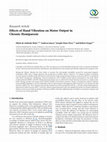
International Journal of Brain Science, 2015
Background. Muscle vibration has been shown to increase the corticospinal excitability assessed b... more Background. Muscle vibration has been shown to increase the corticospinal excitability assessed by transcranial magnetic stimulation (TMS) and to change voluntary force production in healthy subjects. Objectives. To evaluate the effect of vibration on corticospinal excitability using TMS and on maximal motor output using maximal voluntary contraction (MVC) in individuals with chronic hemiparesis. Methodology. Nineteen hemiparetic and 17 healthy control subjects participated in this study. Motor evoked potentials (MEPs) and MVC during lateral pinch grip were recorded at first dorsal interosseous muscle in a single session before, during, and after one-minute trials of 80 Hz vibration of the thenar eminence. Results. In hemiparetic subjects, vibration increased MEP amplitudes to a level comparable to that of control subjects and triggered a MEP response in 4 of 7 patients who did not have a MEP at rest. Also, vibration increased the maximal rate of force production (d /d max ) in both control and hemiparetic subjects but it did not increase MVC. Conclusion. Motor response generated with a descending cortical drive in chronic hemiparetic subjects can be increased during vibration. Vibration could be used when additional input is needed to reveal motor responses and to increase rate of force generation.
e-News Somatosens Rehab, 2017
Clinicians and researchers work hand in hand to investigate and understand functions und dysfunct... more Clinicians and researchers work hand in hand to investigate and understand functions und dysfunctions of pain. So could we dream of a life without pain ? Certainly not, when it comes to its function as a necessary protection mechanisms that accompanies us through our development. But when it comes to pain that becomes a conqueror who invades our bodies we dare to dream of a life without it.
Somatosens Rehab Neuropathic Pain by Sibele de Andrade Melo Knaut
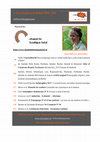
e-News Somatosens Rehab, 2018
Does technology such as virtual reality have
a role in the treatment of pain?
The literature aro... more Does technology such as virtual reality have
a role in the treatment of pain?
The literature around VR and pain is growing daily. However, much of it is limited to small
sample sizes, lack of control groups, poor outcome measurement and lack of appropriate follow
up. Opportunities abound to harness this multisensory world, in critically thought out trials, to
address the various neurophysiological changes found in persistent and complex pain
conditions. Exploring the technology first will allow clinicians to truly see the diverse array of
possibilities rather then apply it solely to achieve an upscale version of an old treatment. It is
likely that the greatest success will be found in program+ms that allow adjustments in VR
programs to individuals’ neurophysiological contexts rather than a one size fits all model.
However, this will bring large challenges in proving efficacy in trials.
e-News Somatosens Rehab, 2017
« Aujourd’hui, je sais qu’il n’y a qu’une seule liberté, la
liberté intérieure (…). Ainsi, ma quê... more « Aujourd’hui, je sais qu’il n’y a qu’une seule liberté, la
liberté intérieure (…). Ainsi, ma quête, loin d’être achevée commence à peine.
Et si je suis
fière du
chemin
parcouru, je
me sens
humble – ô
combien ! –
devant celui
qu’il me
reste à
entreprendre.
C’est le
mien. Il n’y
en a aucun
autre
identique
dans toute
l’histoire du
monde. Il a
ses jours de
faiblesse et
de peine, ses
veilles de
rien, ses
matins de
labeur et ses
soirs de
grâce.
임현정


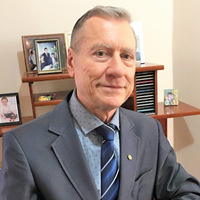



Uploads
Papers by Sibele de Andrade Melo Knaut
Les objectifs de l’équipe interdisciplinaire :
Diminuer la douleur de 50 % (Cruccu & Truini, 2017) ;
Diminuer le score au Questionnaire de la Douleur St-Antoine de 30 pts ou plus ;
Atteindre un score, au questionnaire de la douleur, inférieur à 20 pts (ou un score inférieur à 3 cm sur une l’Echelle Visuelle Analogique).
https://urlz.fr/9MWE
1. La plainte du patient ;
2. L’anamnèse clinique ;
3. L’examen clinique ;
4. La neurographie sensitive pure.
Ce groupe d’experts a été mandaté par l'International Association for the Study of Pain (IASP), sous l’égide de son ancien président, médecin allemand et professeur de neurophysiologie : Prof. Dr. med. Rolf–Detlef Treede.
Hypersensitive, irritable, nervous: « that’s not me »
Contrarily to all common sense
Who is to blame? : The somatosensory nervous system
A flor da pele, irritável, agressivo: “não sou eu”
Ao contrário do bom senso
Quem é o responsável? O sistema nervoso somatosensorial
Le besoin d’intégrer l’EBP trouve ses raisons profondes dans le but d’améliorer la pratique clinique et ses résultats chez nos patients. L’EBP est un sujet d’intérêt depuis le milieu du XIXe siècle. Sackett et collaborateurs en donnent une définition plus actuelle en 1996. L’EBP est la prise en charge personnalisée de chaque patient grâce à un processus décisionnel délibéré, consciencieux et judicieux intégrant les meilleures données probantes disponibles, l’expertise clinique individuelle du professionnel et les valeurs, préférences et circonstances du patient (Fig. 1).
Comme deuxième conclusion, la théorie de la porte abandonne la notion de douleur purement sensorielle et véhiculée directement au cerveau. Bien qu’elle ne rende pas compte de certains mécanismes cérébraux de la douleur, elle présente une conception dynamique de celle-ci : elle intègre d’autres dimensions de la personne, bien au-delà du dualisme corps-esprit (Le Breton, 2017). C’est seulement ainsi que nous pouvons tracer un chemin qui tente d’appréhender le phénomène de la douleur UNIQUE de chaque patient, qu’elle persiste ou non dans ses dimensions biologique, psychologique, sociale et interpersonnelle.
Somatosens Rehab Neuropathic Pain by Sibele de Andrade Melo Knaut
a role in the treatment of pain?
The literature around VR and pain is growing daily. However, much of it is limited to small
sample sizes, lack of control groups, poor outcome measurement and lack of appropriate follow
up. Opportunities abound to harness this multisensory world, in critically thought out trials, to
address the various neurophysiological changes found in persistent and complex pain
conditions. Exploring the technology first will allow clinicians to truly see the diverse array of
possibilities rather then apply it solely to achieve an upscale version of an old treatment. It is
likely that the greatest success will be found in program+ms that allow adjustments in VR
programs to individuals’ neurophysiological contexts rather than a one size fits all model.
However, this will bring large challenges in proving efficacy in trials.
liberté intérieure (…). Ainsi, ma quête, loin d’être achevée commence à peine.
Et si je suis
fière du
chemin
parcouru, je
me sens
humble – ô
combien ! –
devant celui
qu’il me
reste à
entreprendre.
C’est le
mien. Il n’y
en a aucun
autre
identique
dans toute
l’histoire du
monde. Il a
ses jours de
faiblesse et
de peine, ses
veilles de
rien, ses
matins de
labeur et ses
soirs de
grâce.
임현정
Les objectifs de l’équipe interdisciplinaire :
Diminuer la douleur de 50 % (Cruccu & Truini, 2017) ;
Diminuer le score au Questionnaire de la Douleur St-Antoine de 30 pts ou plus ;
Atteindre un score, au questionnaire de la douleur, inférieur à 20 pts (ou un score inférieur à 3 cm sur une l’Echelle Visuelle Analogique).
https://urlz.fr/9MWE
1. La plainte du patient ;
2. L’anamnèse clinique ;
3. L’examen clinique ;
4. La neurographie sensitive pure.
Ce groupe d’experts a été mandaté par l'International Association for the Study of Pain (IASP), sous l’égide de son ancien président, médecin allemand et professeur de neurophysiologie : Prof. Dr. med. Rolf–Detlef Treede.
Hypersensitive, irritable, nervous: « that’s not me »
Contrarily to all common sense
Who is to blame? : The somatosensory nervous system
A flor da pele, irritável, agressivo: “não sou eu”
Ao contrário do bom senso
Quem é o responsável? O sistema nervoso somatosensorial
Le besoin d’intégrer l’EBP trouve ses raisons profondes dans le but d’améliorer la pratique clinique et ses résultats chez nos patients. L’EBP est un sujet d’intérêt depuis le milieu du XIXe siècle. Sackett et collaborateurs en donnent une définition plus actuelle en 1996. L’EBP est la prise en charge personnalisée de chaque patient grâce à un processus décisionnel délibéré, consciencieux et judicieux intégrant les meilleures données probantes disponibles, l’expertise clinique individuelle du professionnel et les valeurs, préférences et circonstances du patient (Fig. 1).
Comme deuxième conclusion, la théorie de la porte abandonne la notion de douleur purement sensorielle et véhiculée directement au cerveau. Bien qu’elle ne rende pas compte de certains mécanismes cérébraux de la douleur, elle présente une conception dynamique de celle-ci : elle intègre d’autres dimensions de la personne, bien au-delà du dualisme corps-esprit (Le Breton, 2017). C’est seulement ainsi que nous pouvons tracer un chemin qui tente d’appréhender le phénomène de la douleur UNIQUE de chaque patient, qu’elle persiste ou non dans ses dimensions biologique, psychologique, sociale et interpersonnelle.
a role in the treatment of pain?
The literature around VR and pain is growing daily. However, much of it is limited to small
sample sizes, lack of control groups, poor outcome measurement and lack of appropriate follow
up. Opportunities abound to harness this multisensory world, in critically thought out trials, to
address the various neurophysiological changes found in persistent and complex pain
conditions. Exploring the technology first will allow clinicians to truly see the diverse array of
possibilities rather then apply it solely to achieve an upscale version of an old treatment. It is
likely that the greatest success will be found in program+ms that allow adjustments in VR
programs to individuals’ neurophysiological contexts rather than a one size fits all model.
However, this will bring large challenges in proving efficacy in trials.
liberté intérieure (…). Ainsi, ma quête, loin d’être achevée commence à peine.
Et si je suis
fière du
chemin
parcouru, je
me sens
humble – ô
combien ! –
devant celui
qu’il me
reste à
entreprendre.
C’est le
mien. Il n’y
en a aucun
autre
identique
dans toute
l’histoire du
monde. Il a
ses jours de
faiblesse et
de peine, ses
veilles de
rien, ses
matins de
labeur et ses
soirs de
grâce.
임현정
• Clinical factors predict approximately 70% of CPSP risk (Montes et al., 2016): type of surgery, age, physical and mental health, and preoperative pain (at the surgical site or other location);
• A prospective risk-factor analysis identified five key predictive factors: emotional overload/overstrain, preoperative pain in the area to be operated upon, other chronic preoperative pain (e.g., headache), acute postoperative pain, and comorbid stress symptoms such as tremulousness, anxiety, rumination, magnification, helplessness or disturbed sleep (Althaus et al., 2012);
• Preoperative use of opioid increases the risk of CPSP with an RR of 2.0 (95 percent confidence interval, 1.2-3.3) (VanDenKerkhof et al., 2012);
• Postoperative pain is an important determinant of the development of CPSP, particularly the duration of severe pain after surgery, i.e., the amount of time spent in severe unrelieved pain rather than, for example, a single peak pain intensity rating (Fletcher D, et al., 2015);
• Early NP might predict neuropathic CPSP (Martinez et al., 2012).
The somatosensory rehabilitation method is recommended for the detection, classification and treatment of NP following orthopaedic surgery (Spicher et al., 2016).
Let me introduce myself. I am an occupational therapist working in a private clinic since 2014, also practicing with a physical and mental health clientele living with chronic pain.
Having a keen interest in understanding and managing pain, I completed a 2.5-year graduate certificate on chronic pain management at McGill University. Still not having satisfactory answers concerning the management of neuropathic pain after my graduation in 2018, I followed the training on somatosensory rehabilitation of pain the next year.
It was during this training that I saw great potential in the approach and came to realize that I could have used it with my past problematic cases of neuropathic pain. Unfortunately, their condition had been ignored/not treated effectively by all of the professionals in their file, due to a lack of knowledge.
J'aime qu'il s'adresse à mon mari et à Jérémie, notre fils aîné, à plusieurs reprises dans les deux premières heures. On est dans la même barque. Quant à moi, il décèle où j'en suis. Figée. Fatiguée. Il m'imprime un article (Masse et al., 2018) qui parle de liminalité, d’état de flottement et d'errance, ni ici, ni là-bas, ni comme avant, ni dans un nouveau statut post blessures ; un peu comme un rituel de passage lors duquel l'individu n'a plus son ancien statut, mais pas encore le nouveau. Finalement, après trois heures de séance, je repars avec un dessin résumant et illustrant les deux maladies dont je suis atteinte : le CRPS caractérisé par une hypoesthésie (petits points en vert) et une allodynie (petits points en violet) qui induit une douleur au toucher, persistant dans la durée alors que le stimulus n'est plus là. Nommer, c’est reconnaître et cela fait du bien.